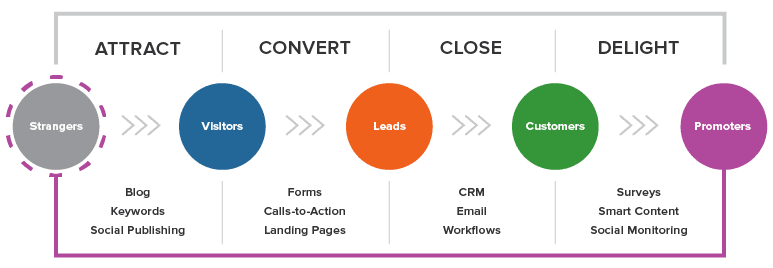You've probably heard a lot about growth marketing by now and how you need to get on board with growth strategies or risk being left behind by your competitors.
Like most new endeavors, that likely seems easier said than done.

As a small or midsize business (SMB) setting out on your growth marketing journey, you need to know where to look and what to do to kick things off.
The best way to start? Take a look at some current, common best practices used by other successful SMB marketing teams. We've rounded up three to get you started.
Successful growth marketing centers on customer experience
According to Salesforce's 2018 "State of Marketing" survey, "high-performing marketing teams are 8.8 times more likely than underperformers" to have "adopted a customer journey strategy as part of their overall business strategy."
Additionally, the survey found that "among top teams who have integrated their digital marketing channels with their overall marketing, at least 95% rate the integrations as very effective or effective."
This means that integrated, customer journey-focused growth marketing plans are dominating current growth marketing trends, and your SMB should adopt such tactics ASAP.
3 strategies to improve your customer journey-focused growth marketing efforts
1. Get the lead(s) out
Let's throw the most obvious strategy out there right away: Growth marketing—like all forms of marketing—relies on getting leads.
Leads are any contact—either individual or business—that has the potential for conversion to customer. One of the key goals of marketing (growth or otherwise) is to obtain leads that members of your marketing team and/or your sales team can ultimately convert into customers.

A HubSpot chart showcasing the important role that lead generation plays in the customer journey (Source)
As Tatsuya Nakagawa, vice president of marketing and strategy at Castagra Products, Inc., points out: “Effective lead generation is the cornerstone of any growth strategy."
Nakagawa recommends that you "explore and pinpoint the tactics that work well for your business and scale them up aggressively."
Since leads derive from a wealth of channels, lead generation can take a variety of forms, including:
Website forms
Virtual events
Trade shows
Direct mail
Phone calls
Though growth marketing focuses on all of your funnel stages, make sure you have enough focus on the top of that funnel in order to bring in leads you can nurture.
Strategy 1: Early on in your marketing process, widely engage in a variety of types of lead generation and capturing in order to learn which methods and channels are most fruitful for your industry and business. Once you have data telling you which channels work best, scale up those methods to obtain more leads quickly.
2. Engage your customers at all points in their journey
Though leads are important to growth marketing, the process differs from other types of marketing because leads aren't all-important to growth marketing.
Jenna Erickson, marketing manager at Codal, explains that:
Growth marketing is about attracting engaged customers. Growth marketers don't just think about the top of the funnel, they think about the entire funnel and focus on acquiring long-term customers.
One of the best strategies to turn your leads into long-term customers is to keep them engaged at all points of their journey, making them feel unique and valued along the entire funnel. You can use drip email campaigns to do this, sending targeted emails to customers triggered by specific actions or timing on their part.
In addition, be sure to take advantage of all the technologies at your disposal. Erickson recommends, for example, using a chatbot on your website. “Getting the user to actually have a conversation with you before they can convert means that they may be more interested than others."
Another method of engagement—perhaps the top method these days—is social media. You need to run tests to figure out which websites your audience spends their time on, and then focus your efforts on those platforms.
Whether that's Facebook, Twitter, LinkedIn, or elsewhere, your social media strategy should run the gamut of different content types, ranging from linking to pieces of content to posing discussion questions, sharing customer success stories, and even humorously responding to users who mention/tag your brand. Check out how large companies are already doing this successfully, so you can learn from their tactics!

Wendy's engages with a fan on Twitter . . . but won't get engaged to that fan (Source)
Hussein Ebeid, senior director of search at PACIFIC Digital Group, suggests that you focus on answering your customers' questions.
There is an endless supply of consumer questions surrounding every type of business that exists. As a growth marketer it's your job to gather those questions and identify the most popular or recurring themes that stand out. By serving the right the type of content across the right consumer touchpoints, you'll increase brand discovery, engagement, sales, and customer retention for your business.
Strategy 2: Engage with your customers at all points along the sales funnel by leveraging tools and technologies such as drip email campaigns, chatbots, and a well-balanced social media content strategy.
3. Identify and break down silos between teams and departments
The first two strategies are focused outward on your customers, but you also need to strategize internally.
Growth marketing, by its very nature of focusing on all funnel stages, requires a lot of different teams—both within and without a traditional marketing department structure—to work together.
You need to consciously and deliberately identify and break down the silos within your organization that separate different teams within your marketing department from one another, as well as those that wall off your entire marketing department from other teams across your company (like the sales department).
Don't just do this metaphorically; bring all of the teams that will participate in your growth marketing strategy into the same room.
Mark Nardone, executive vice president of marketing at PAN Communications, suggests:
Bring your teams and departments together to collaborate on what's next for your brand. Sending one consistent message to your audience and key stakeholders (i.e., your investors) about your strategy is important.
By holding meetings that foster collaboration across departments, you'll establish growth marketing efforts that draw on the expertise of individual teams, allowing you to figure out the best ways to target your customers at each stage along their journey.
Strategy 3: Break down the silos housing your individual teams and departments so you can create a single, cohesive growth marketing plan that takes specific talents and insights of both individuals and teams into consideration.
More steps to improve your strategies
These three strategies will set you well on your way in your growth marketing journey, but there are some more immediate next steps to take as you implement your long-term plan:
Research software: A fully developed marketing plan frequently involves a lot of rote, repetitive tasks, many of which can be handled by marketing automation software. Lead generation software will help you start off on the right foot with one of the cornerstones of your growth marketing strategy. Explore available features and dive into some vendor offerings to find a system that meets your business's needs!
Learn more about growth marketing: Read our guide to developing a growth marketing mindset at your SMB to ensure you have the broadscale overview necessary to develop solid growth marketing strategies.
Take part in the conversation: Leave a comment or question below to start a discussion about marketing strategies for small businesses and learn from your peers who respond!
Thinking about hiring a digital marketing agency to help your business grow? Browse our list of top digital marketing agencies and learn more about their features in our hiring guide.